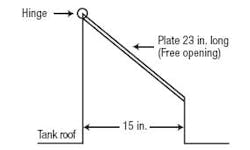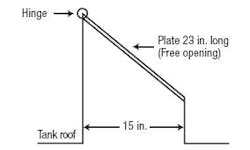October Process Puzzler: Keep a float from sinking operation
|
Question from August's Chemical Processing |
|
A spray condenser tank uses a float as a level instrument. Metal chlorides settle in the tank and are eventually pumped to waste treatment. Unfortunately, solids build up, especially during start-up, causing failure of the float. Last year alone, eight floats were replaced. Two months ago, two floats were replaced during a single outage, causing more than 30 hours of unexpected downtime. The current instrument is loop-powered. There are no additional points left in the PLC for self-powered instruments. Can you propose alternatives for measuring level? |
Avoid precipitation
A small amount of condensate flush will help keep solids from precipitating into the still well. The small amount will help to keep the flow outward from the still well (or float column) and the condensate also will dilute the concentration of the liquids that do get into the float column.
Bobby J. Hatfield Jr., cat/alky training analyst
ConocoPhillips Co., Sweeny, Texas
Make a sound move
You could try a sonar transmitter. This could give you a non-contact method of determining level. If you have no room left for a four-wire transmitter, you can use a converter to change the four-wire signal to a loop-powered two-wire input and utilize the point that you are replacing!
Steven Dow, Yuba City, Calif.
Measure pressure
I think that I have a very simple answer for your question. You can place a pressure indicator at the lower region of the tank so it senses the liquid level head in the tank. You can calibrate the liquid head (pressure) reading relative to the tank level, when the pressure head varies it is an indication for the liquid level variation.
Amr Hatem Rashed, compressor engineer
Abu Qir Fertilizers Co., Alexandria, Egypt
Use non-contact technology
There isn’t enough information about the installation and available nozzles, but at a guess use radar or sonic.
Bob Driskell, PE, project manager
WorleyParsons,Texas City, Texas
December's Puzzler
We have a fixed-roof fiber-glass storage tank. It was originally equipped with a typical weight-type tank pressure relief valve set to open at 2 in. of water column pressure. After adding in a vapor recovery system to the tank we changed this to an 8-in.-of-water-column vent. The replacement vent was fabricated by the tank manufacturer and is shown in Figure 1. It was installed by cutting out the previous nozzle for the pressure relief valve and making a large riser integral with the tank roof. The replacement vent uses a 15-in.-diameter round riser coming up to a hinged plate. The weight of the plate was set by selecting the right metal thickness to get a weight of 41.6 lb/ft2 or 8 in. of water column. After the new vent was installed, we ended up changing our vapor recovery system and now the tank could be reset to a 2-in.-of-water-column relief point again. Unfortunately, we can’t find the original pressure relief valve.
When we started a new HAZOP on the tank, our engineering consultants didn’t want anything to do with our current vent valve — they hadn’t seen anything like it before and didn’t know how to evaluate it. They claimed that the documentation on the relief rates and settings was incomplete and, in spite of “not knowing” how to evaluate it, there were obvious errors in the calculations. They only would consider installing a commercially available pressure relief valve for the tank to replace the existing vent. However, that requires taking the tank out of service, cleaning it out and then adding a new nozzle or opening in the tank. We don’t want to do this unless we have to. Do you have experience with a vent like the one now installed or know how to evaluate its opening pressure and flow capacity?
Figure 1. Unusual design complicates the evaluation of key parameters.
Send us your comments, suggestions or solutions for this question by November 5, 2007. We’ll include as many of them as possible in the December 2007 issue and all on CP.com. Send visuals — a sketch is fine. E-mail us at [email protected] or mail to ProcessPuzzler, Chemical Processing, 555 W. Pierce Rd., Suite 301, Itasca, IL 60143. Fax: (630) 467-1120. Please include your name, title, location and company affiliation in the response.
And, of course, if you have a process problem you’d like to pose to our readers, send it along and we’ll be pleased to consider it for publication.

